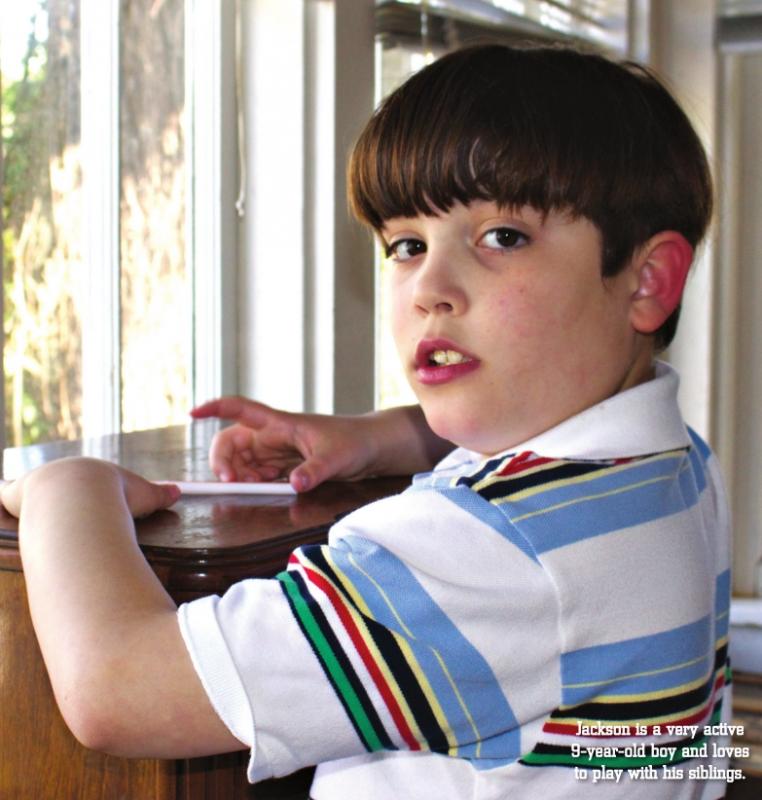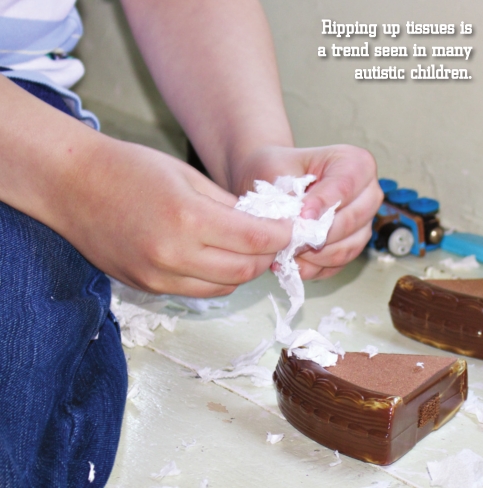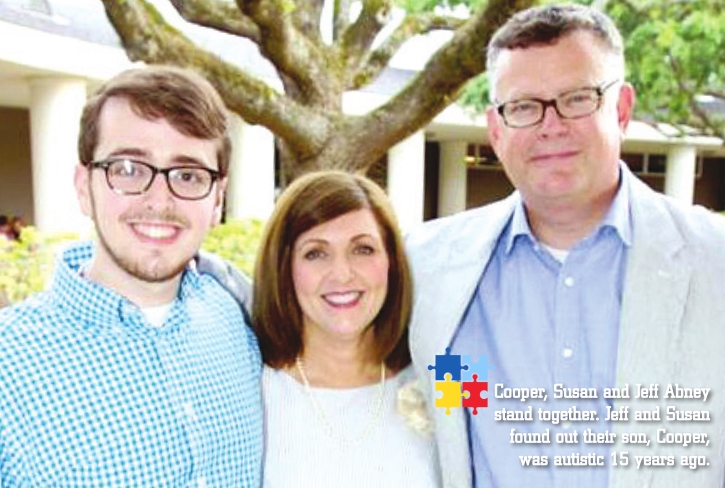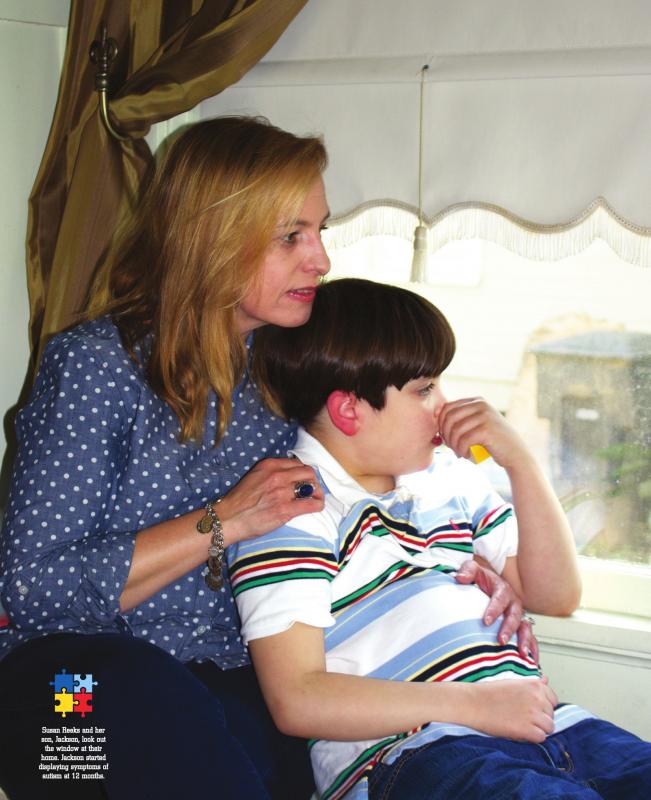
Mother and son find autism community and piece together support
They say if you’ve met one person with autism, you’ve met one person with autism. Each case comes with a varying set of deficits that impairs a person’s ability to communicate or interact with others. The real key to helping someone manage the symptoms of autism spectrum disorder is a customized treatment approach that involves: addressing any physical health issues; changing behavior to help a child cope with obsessive compulsive characteristics and sensory issues; and customizing an education plan that evolves to fit the specific needs of each child.
There is no cure for ASD. The goals often become education, behavior management and providing quality of life to keeping families whole. It requires an individualized master plan to make it all happen. The lack of time and money it takes to adequately inform and guide parents in that process is what is really preventing many of the 3.5 million people living with ASD in the United States from getting the adequate help they need.
My experience with ASD comes from my 9-year-old son Jackson, who was diagnosed at 24 months. Jackson met his milestones and began using words like “Mommy,” “Daddy” and “Sponge Bob,” but after we put him on cow’s milk at 12 months, we began to notice changes. He began to cry as if he were in pain and often vomited before bedtime. He stopped using his words, and he would sit in the corner and stare at sunbeams streaming through the windows. He stopped gesturing at all. In fact, when I tried to get him to point to objects in a book, he would grab my finger and use it to point. Instead of asking for milk, he would take my hand and lead me to the refrigerator. When we called his name or said, “Look at me,” he would ignore us. Getting him to go to sleep at night became a three-hour struggle, with me lying next to him while he tossed and turned, sometimes accidentally butting me in the head while I cried myself to sleep.
Perhaps the most
heartbreaking of all was that he would not kiss me. In fact, if you
wanted to hug him he would back up into you in a backward hug. He
started developing even more bizarre sensory problems, such as tearing
paper out of books and eating it, and smearing his own feces on walls
and toys. He also self-selected his food, only wanting to eat bread,
fries and milk. We stopped taking him outside because he would bolt and
run away or plunge his hands into ant hills. A hallmark of his behavior
was how compulsive he was about certain things and how obsessive he
could be about getting them.
When
I asked our pediatrician about Jackson’s loss of language, he referred
us to a pediatric neurologist at LSUHSC, but there was a 10-month wait.
(In fact, we ultimately decided to drive to Monroe and see a private
pediatric neurologist, who got us in six months sooner). While we
helplessly waited, I went to autismspeaks. org and started reading. When
I clicked on the videos of children with ASD doing activities alongside
videos of children not on the spectrum performing the same activities, I
had my answer. When I was watching the ASD children, it was like
watching Jackson.
I
also came across links to pages on special diets such as gluten-free,
casein-free. I also found a link to a book by Dr. Kenneth Bock that
changed our lives: “Healing the New Childhood Epidemics: Autism, ADHD,
Asthma and Allergies.” With no other options and Jackson vomiting more
and more, I decided to remove milk from Jackson’s diet. The vomiting
stopped and within two days, Jackson was making eye contact with us. On
the third day, he began coming up to me and kissing me. To say we were
ecstatic is an understatement. All day long, Jackson would compulsively
come up to me and grab my face and kiss me, and I would yell out to my
husband, Stuart, “Kiss number 17!” Each time we would all dissolve into
happy tears. We removed wheat from his diet that very same day.
By the Numbers
April
is Autism Awareness month and each April 2, Autism Speaks
(www.autismspeaks.org) celebrates “Light It Up Blue” in commemoration of
the United Nations-sanctioned World Autism Awareness Day.
It
is crucial that people accept the numbers of those being diagnosed with
ASD are growing at a terrifying rate. According to the Centers for
Prevention and Disease Control’s most recent report in 2014 that is
tracking ASD, about 1 in 68 children in the United States has ASD, but
it is five times more prevalent in boys where the rate is 1 in 42.
If
this isn’t cause enough for concern, consider this: Autism services
cost U.S. citizens $236 to 262 billion annually, a majority of which is
for adult services at $175 to 196 billion annually. (An estimate from
Autismsociety.org concludes the annual cost in 10 years will be $200 to
400 billion.) However, Autism Society claims the cost of lifelong care
can be reduced by two-thirds with early diagnosis and intervention.
Symptoms
such as those exhibited by Jackson are often apparent between 18 to 24
months and become more defined between 2 to 6 years of age. The
diagnosis process was reclassified last year to include the classic five
disorders of autism, Aspergers, Rett Syndrome, Childhood Disintegrative
Disorder and PDD-NOS all under the umbrella of autism spectrum
disorder. This new classification is encouraging because it recognizes
the potential for movement and improvement along the spectrum.
Pediatric
neurologists, pediatric psychologists, developmental pediatricians and
speech/language pathologists can evaluate for ASD, but sadly,
Shreveport- Bossier City doesn’t currently have a developmental
pediatrician. There are often waiting lists for existing services, so
parents with the means often travel out of town and even out of state
for services.
Local Resources
Michelle
Yetman is a clinical psychologist who oversees the diagnosis of
children with developmental delays at LSUHSC School of Allied Health and
Children’s Center. Yetman’s department does not yet provide treatment
to the area because they are overwhelmed with providing diagnoses.
“One
in 68 [children],” Yetman said. “This should alarm us all. Our focus
now is on early diagnosis and we are it for the northern part of the
state. Once we diagnose, we can hook them up with community resources.
Early identification makes a world of difference with outcome.”
Part
of the problem with getting an early diagnosis is a lack of knowledge
about ASD, even in the medical community. “One of the ways we’re
changing that is that every third-year medical student here, even if
they don’t work with kids, has to rotate through our department,” Yetman
said.
ASD manifests
differently in each person and can seem like a wide range of behavior
from one person to the next. “But it’s all the same behavior,” Yetman
said. “Think of a triangle with three points. [First is] communication,
where the low end is non-verbal and no eye contact, but someone with
Aspergers can talk but still has problems with communication. They don’t
understand jokes, figures of speech or non-verbal communication such as
body language. The next point in the triangle is social, from having no
interest in other kids to Aspergers, where they may very much want
friends but not know how to make them because they can be awkward. The
third point on the triangle is restricted or stereotype interest, where
on the low end you might have classically autistic features, like the
toe walking or the hand flapping, to the high end, where you have that
restricted range of interest, where he or she knows everything about
Botany or everything about ‘Star Wars.’ It is very rigid and narrow in
focus. So regardless of where you fall within the spectrum, we still see
that three-point deficit.”
One
of the problems that delays diagnosis is a gap that occurs between the
first notice of symptoms and the time of referral. “When you ask moms,
‘When did you first suspect something was wrong?’ you usually find it is
six months to a year between the point where the mom approaches the
pediatrician and when they actually get help,” Yetman explained.
Yetman
said they are pushing for early screening. “We have a contract with
Early Steps, which is the one-to-three year provider. All our
pediatricians working at the children’s clinic use the screening check
list at the 18-month well-baby checkups. This is in compliance with
national standards. If those kids fail their screeners, they should be
referred to someone somewhere like the [LSUHSC] Children’s Center, where
they get a comprehensive evaluation.”
When
asked about other common health problems associated with ASD, such as
digestive problems, Yetman said, “What we see is a lot of chronic
constipation. It’s not because we see it so consistently across the
board. It is characterized by their restricted diet. By that I mean the
mom can tell me literally the six things the child eats. It’s typically a
carbohydrate-based diet, grain and dairy, and incredibly rigid. A child
with ASD might actually starve himself to death rather than eat an
undesirable food item.”
When
asked about possible causes of ASD, Yetman said there is a lot of
research looking at a genetic and environmental component. “A study I
just read about is called the Tooth Fairy Study where they are
collecting baby teeth after they fall out to determine what toxins these
children were exposed to. Pesticides, toxins and pollutants all lay
down in the enamel. They are comparing teeth from ASD children to non-
ASD children,” Yetman said. “And we now know with the prenatal studies
that women who have been exposed to a high level of pollutants when they
are pregnant do have an increased risk of having a child with autism.”
Effective
treatments recommended by Yetman and her department include speech
therapy, occupational therapy and applied behavioral analysis. “You have
to understand what is driving the behaviors,” Yetman said. “Sensory
integration therapy, ABA and social skills training can all help with
sensory issues.” ‘Anacdotal Observation’ I had the opportunity to
sit down with Diana Townsend, whose 3-year-old son Blayne was recently
diagnosed with ASD at LSUHSC. It is evident how much time Townsend has
already spent trying to help Blayne.
“He
has verbal delays,” she said. “If you point to something, he can tell
you what it is but he can’t make a sentence. We work with him every
chance we get.”
Blayne
seemed like any other happy developing child until he was 12-monthsold.
“He met every milestone,” Townsend said. “He said, ‘Mama,’ he had great
eye contact – until about 12 months. I thought he had hearing problems.
I’d talk to him and he’d look straight through me. Or I’d come home and
yell, ‘Where’s Mama’s baby?’ and he wouldn’t meet me at the door like
he used to.”
The
day-to-day drain that destroys quality of life and the goals parents
have for their ASD children is already present in the Townsend family.
“We can’t let him play like other kids, not even down the hall. Blayne
will be out the door. He gets into stuff outside and he loves water. If
he sees some kind of water outside, that’s where he’s going to be. And
he compulsively tears up things like tissue or Play Doh, and the little
pieces get all over the house.”
I
wasn’t surprised to hear that Blayne also has a milk intolerance. “The
daycare kept calling me and telling me he was throwing up on the
playground. At first, I thought it was a stomach virus, but none of the
rest of us would get sick. Then I noticed that every time I reintroduced
milk, he would throw it up. So I put him on almond milk and it stopped.
Later, a [gastrointestinal] doctor confirmed milk protein enteropathy.”
This
parent detective work, referred to by many doctors we encounter as
“anecdotal observation,” is another common thread found in ASD
households. We talk to other parents and find out what they’ve tried and
a part of the criteria, but we ask about it research
topics ourselves, trying whatever seems logical and sticking with the
things that give us results. “We are also off of gluten,” Townsend said.
“It has helped tremendously with his belly, and we saw a definite
improvement with eye contact.”
Parents
aren’t the only ones on the gluten-free, casein-free diet bandwagon.
Integrative doctors have been looking at the growing body of research
available on diet, the digestive system and inflammation, and how those
might affect development in children for some time now.
A Healthy Gut 
Dr.
Betsy Hendricks is an integrative doctor practicing in Conway, Ark.
“Integrative medicine uses a different model,” Hendricks said. “Instead
of arriving at a diagnosis and selecting a medication or other therapy,
we look at what appears to have made the individual sick and how to
address that from a biochemical perspective. It is much more time
intensive, and the patient and family often have to be very active
participants.”
When
asked about the actual cause of ASD, Hendricks said, “The more I read
the research, the more I see that evidence is pointing to inflammation,
specifically neuroinflammation. We are also seeing an increase in toxic
burden, much of which is passed from mother to child in utero and then
through breast feeding.”
“Then
we see the resources of the child being engaged with trying to manage
this toxic load,” Hendricks said, “and thereby having a reduced ability
to handle inflammation. Nutrient deficiencies related to both the
standard American diet and the child’s decreased ability to absorb
nutrients due to a damaged GI tract and imbalanced microbiome further
complicate things. Finally, there is a shift in the immune system toward
more allergies and auto-immune disease, possibly secondary to toxins
and a decrease in available glutathione.”
When
Hendricks treats a patient, she has the patient or parents complete a
thorough health history, then orders thorough lab work, including urine,
stool and blood samples, to evaluate what is going on in that patient’s
body. Diet changes and probiotic therapy are often the next step.
“We
have to begin to do everything we can to reduce inflammation and help
with repair,” she said. “So, the first thing we often do is to change
the diet to remove foods that are the most inflammatory. This is the
basic reason for the gluten-free, casein-free diet. We also want to
remove toxins from the child’s environment while we replace needed
nutrients and use nutrient-dense foods to help with repair.”
This
concept might seem somewhat new to Western medicine, but doctors in the
East have long referred to the gut as “the second brain.” A healthy gut
full of good flora allows the body to absorb and use nutrients in the
correct way, which is crucial in the early childhood development years. A
healthy gut in a child also helps build an immune system that can
better handle the toxins and allergens he or she encounters. An
unhealthy gut struggles to absorb and use vitamins even if they are
ingested.
The American
Academy of Pediatric Allergy and Immunology does not formally recognize
the type of testing that integrative doctors are doing all over the
world, including in the United States, even though parents are observing
with their own eyes healthier children. Hendricks said, “I think that
is because IgE mediated reactions are the only recognized type of
reaction. I also test for IgG mediated food sensitivities. The IgG
reactions are not true allergies, but still give us important
information about what the immune system is reacting to.”
It
is these food sensitivity “reactions” that have the potential to make
life miserable and put the brakes on healthy development, limiting the
potential for quality of life. I have learned reactions like Jackson
throwing up from eating a food, his eyes swelling shut from being
exposed to a strong scent, or his body breaking out in a perfect
T-shirt-shaped rash due to his shirt being laundered in certain
detergents, are reactions considered an allergy in mainstream medicine.
When he eats wheat or gluten, it is like a narcotic to him because he
has a toxic reaction. Yet, when I explain these things to mainstream
doctors, I see them glaze over. They assume we are trying to “cure” ASD,
when we are merely trying to manage these very real medical symptoms.
A Life-long Process
Hendricks
maintains there is ever growing research that supports this type of
treatment and its help to patients and she covers that research in her
book “Zero Point, Where Worlds Collide and Autism is Born.”
“Recovery
is a life-long process,” she said. While many parents are taking the
integrative approach into their own hands, many of them are combining it
with therapy, as well. One of the most effective approaches is applied
behavioral analysis, which systematically applies interventions to
modify behavior. It is extremely helpful with language development,
sensory issues, social behavior, toilet training and food issues. It was
in ABA therapy where Jackson finally started talking and it was with
ABA principles that we finally got him toilet trained, both of which
occurred at 5-yearsold. The good news is ABA improves the lives of those with ASD
and their families, and it is covered under most private insurance as
well as Medicaid. The bad news is that to be effective, significant
hours per week have to be devoted to it in the therapy setting and the
home, and there is a shortage of ABA therapists in North Louisiana.
There are only two private therapy centers in Shreveport-Bossier City
that offer ABA, as well as one tuition private school program at The
Educational Center for Autism. Some parents make the decision to get
training themselves so they can help their own child.
In College with Autism 
There
was no ABA to be found in Louisiana when Jeff and Susan Abney found out
their son Cooper was autistic 15 years ago. Jeff said he and Susan were
hitting a level of despair about how to reach Cooper.
“He
could only be described as miserable,” he said. “We had to have an
action plan for every single act that involved him outside our home,” he
said, “whether it meant how to take him into a store with us to calming
him down when the doorbell rang. Social settings were terrifying for
him. Going to family events or friends’ homes became impossible.”
Perhaps the worst part was that Cooper wouldn’t even look at his parents. Meanwhile Jeff did the only thing he could do.
“I
started researching potential diagnoses in the bookstore and the early
online communities, and ABA immediately came up as a possibility,” he
said. “It was the only strategy, with thorough, peer-reviewed research
behind it.”
About
eight months into the ABA program, they saw the first major sign that
the hours of verbalization strategies they had done were starting to pay
off.
“Cooper was in
his bedroom playing by himself,” Jeff said, “and we heard him yell,
‘Mommy, come here, I need you!’ We both thought we were hearing things
when he said it again, and then of course, we both got weepy.”
That
was the turning point for Jeff and Susan, and from then on, they saw
language acquisition, including sentences. “But it all started with very
basic, very discrete goals,” Jeff said. “For example, matching.
Everything in ABA is a stepwise process, and skills are modified and
made more complex as they are mastered.”
The
Abneys were also pioneers in the battle for an equal and appropriate
public education for Cooper in Caddo Parish. What the Abneys have
produced is a smart but genuinely nice 19-yearold man who now lives on
his own and studies geology at Mercyhurst University in Pennsylvania. “I
like Mercyhurst because the classes are small enough that all the
teachers know you as an individual,” Cooper said. “But the school is big
enough to have many majors, including the archaeology program that my
geology major is a part of.”
To
hear this formerly nonverbal ASD child describe how he has breezed
right through the first-year-at-college transition moves me beyond
words.
“While the
first semester was stressful due to settling in so far away from home,
and a particularly tough pre-calc teacher, I’ve found quite a few
friends to do things with when we aren’t busy. I’ve also been excited
since I learned that my paleontology class will take field trips in the
near future for fossil digs.”
Also,
there are perks to being at a university that houses and educates so
many brilliant spectrum minds. “The movie club that I’m in will be among
the first people in the country to see ‘The Avengers 2,’” Cooper said.
I
asked Cooper if he had any advice for parents of young children on the
spectrum and he said, “Be patient with them and try to get treatment as
soon as you can. It might make all the difference. Also, try to
understand the world from the perspective of your child.”
Another
significant therapy option, which is often combined with ABA, is
occupational therapy. Suzanne McMillian has been a pediatric
occupational therapist for 22 years. “Children that do not have ASD
develop and learn through interaction, playfulness and an understanding
of social and emotional exchange with their parents,” she said.
“Children with ASD do this also, but often in very different ways.”
McMillian
likes to figure out what motivates the child at home and then applies
that to the therapy environment. “For example, with a picky eater,” she
said, “does he or she like Legos, tactile toys or video games? We use
what the child is interested in to motivate trying new foods.”
Many
times the OT center becomes the place for emotional support for
families, as well. “ASD is such a big diagnosis,” McMillian said. “I
want people to be aware of how isolated parents may feel. It’s also
important to understand that just because a child doesn’t speak, doesn’t
mean they have cognitive delays or that their receptive language is not
typical. These kids are often brilliant, funny, mischievous, sarcastic,
lonely, afraid and affectionate.”
Both
the Abneys and McMillian agree that parents should not depend on the
school to automatically meet the needs of a child with ASD. “Remember
that the parent is the child’s voice and they should set up their
educational experience to benefit their child in the best possible
ways,” McMillian said.
In the School Setting
Having
a well-crafted IEP allows students to receive customized services from
teachers, paraprofessionals, occupational therapists, speech therapists,
physical therapists and adaptive physical education teachers. It can
sometimes allow pre-schoolers to receive special services such as
enrollment at 3-to 5-years-old at Caddo Parish’s all-early childhood
education center 81st Street ECE School, which provides a solid start
for children who need something more before enrolling in elementary
school.
I recently
spoke with one Caddo Parish School System teacher who will remain
anonymous. The teacher I spoke with (who I’ll refer to as Teacher Doe)
is a well-respected, 20-year veteran of autism education.
The
primary contrast between the past 20 years and now is in the amount of
freedom a teacher has to customize strategies that can evolve for each
child within the classroom. “We’ve seen a shift to where we are
incorporating more strategies,” Teacher Doe said. “Then, we were given
classroom set-up instructions and a rigid, structured routine based on
the TEACCH program. That’s really all we had, but now we are allowed to
use a combination of strategies, a piece of TEACCH and a piece of ABA,
which is way more successful than just a single approach. It’s
encouraging because it works.”
Elementary
education is definitely improving. The still-alarming aspect is that as
an ASD child ages, his or her education options narrow. For example,
the only two high schools that accept “profoundly delayed” ASD students
in Caddo Parish Schools are Huntington High School and Fair Park College
Prep.
Teacher Doe
would also like to see more community resources for education. “We need a
restaurant that is accepting that we can go into before their rush-hour
lunch so that we can teach some social skills and sit down at the
table. Parents
tell us they can’t take their children to the dentist or to get a
haircut. If we had a barber who was willing to help, it would be great.
Swim lessons are also important because these kids seem to be obsessed
with water.”
Teacher
Doe believes her students are coming in at a different level than they
were 20 years ago, requiring less instructional time or training. “I see
a difference,” she said. “Kids were coming at 5 who weren’t potty
trained or couldn’t do other tasks. That consumes a lot of your time and
it’s valuable instruction time that you’re losing. If they get the
proper early childhood training they need, it makes all the difference
on how far they can progress overall.”
That’s
where the early diagnosis work that Yetman does comes full circle and
you can see all the little pieces around the community beginning to fall
into place. “When I started out,” Yetman said, “I was getting 5- and
6-year-olds. Now all I get are 1- and 2-year-olds. If we get a
5-year-old now, we’re like, who dropped the ball? Fifty percent of our recommendations are going to be school-based.”
Common Goals
When
you take a look from the perspective of each branch of ASD treatment,
from medicine (both mainstream and integrative) to psychology to therapy
to education, you begin to discover that we are all working on some of
the same things, but we’re working our way there from so many different
directions that don’t always cross paths. The towns and states where all
the various entities have come together for some honest dialogue and
planning are where you will find the most effective ASD programs and
services, along with the happiest and healthiest families.
“You
have to be an advocate for your own child and understand more about the
diagnosis and treatment options out there than the practitioners and
educators you’re working with,” Abney said. “Pediatricians and
psychologists now have a much better understanding of the spectrum and
much more experience with diagnosis, but even now, people approach
treatment options with their own attitudes and biases.”
There
is a lot to ask of parents who never chose this path – to be able to
navigate a maze of services with blinders on at the beginning of their
journey. Parents and grandparents have told me more than once that they
would climb any mountain to help someone they love with ASD, but I think
what they envision is climbing a mountain to get the magic pill they
need to cure ASD. There is no pill that will cure ASD, but you can help
someone on the spectrum to achieve quality of life. You just have to
climb that mountain every single day.
